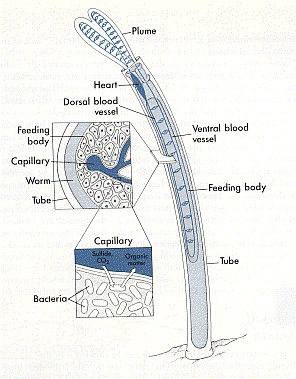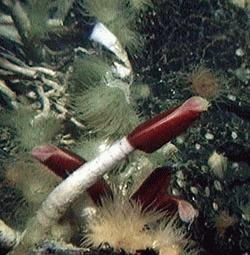Feed the Worm
The areas around the hydrothermal tube vents are mainly oligotrophic and can't support much life. In the total absence of photosynthesis in these environments, the food chain relies entirely on the aptitude of some bacteria to extract energy from the oxideaton of reduced minerals present in the medium(7).
Image taken from www.botos.com
Riftia has over time adapted to this environment which is sparse
in food source by creating a mutualistic symbiosis. As an adult Riftia Pachyptila lacks a functional digestive system, a
mouth, or anus. This means it
cannot feed like normal worms. Instead it holds a symbiotic relationship with a certian type of intracellular chemoautotrophic gamma proteobacteria to meet it's
nutritional requirements. Riftia cannot ingest particulate organic
matter, and flourishes where dissolved organic carbon and nitrogen
concentrations are too low to support the observed biomass (2).
Riftia has highly vascularized gill-like
plumes exposed to vent fluid and
have circulating hemoglobins that bind to both oxygen and sulfide reversibly and
with high affinity and capacity. This allows Riftia to take up and
store large amounts of these
chemoautotrophic substrates, transport them through its tissues with no harmful
effects, and provide its symbionts, who exist in the worm's trophosome, with a
bountiful supply of both(3). The symbionts then fix carbon at high rates as a
nutrient source for the worm. Riftia, it is thought, supplies the bacteria with reduced sulfide
through it's blood stream which the bacteria then oxidizes to get energy for
carbon fixation. The fixed carbon then in turn supplies Riftia with a
more readily usable carbon source than the otherwise dissolved organic carbon in
the surrounding environment. Protien profiling (proteomics) have been used to
obtain a snapshot of the proteins expressed by the Riftia symbiont. Their
results illustrate the degree to which Riftia symbionts are poised for
high rates of chemoautotrophic carbon fixation powered by sulfide oxidation. It
has been found that 12% of the total cytosolic (fluid of the cell) proteome of
these symbionts consists of three proteins involved in coupling energy
production to sulfide oxidation. This is a marked departure from fast growing,
free-living heterotrophic bacteria that instead expend a considerable fraction
of their energy synthesizing amino acids for their own cell division and growth.
The prominence of these three proteins undercores the central role of the
symbionts: to provide nutrition to the association by harnessing energy
from sulfide(3).This relationship between the bacteria and Riftia provide both with an
extremely efficient mechanism for nutrients, thus giving Riftia a large
growth rate and also making it very fertile (3).

